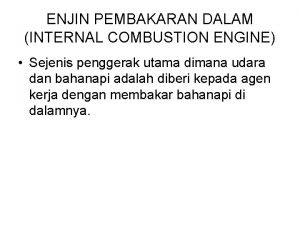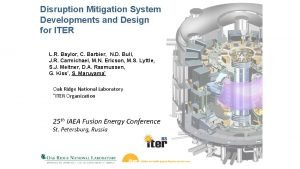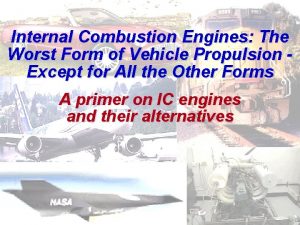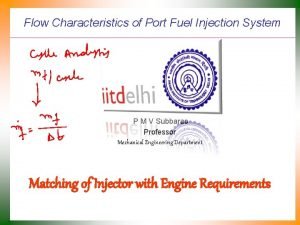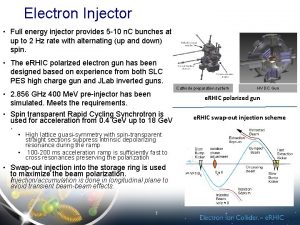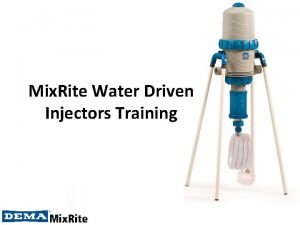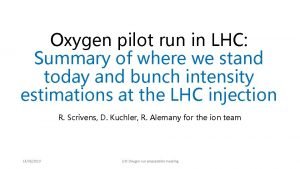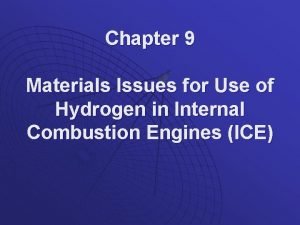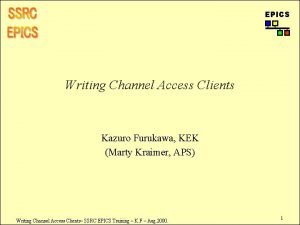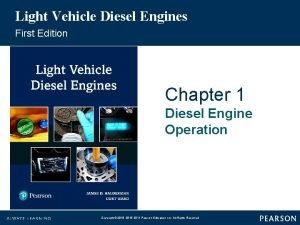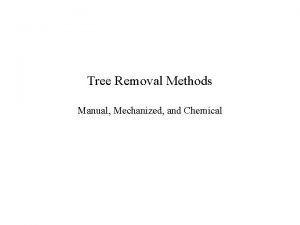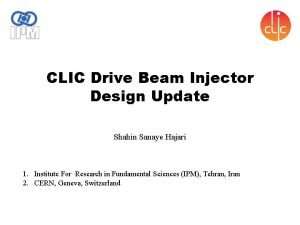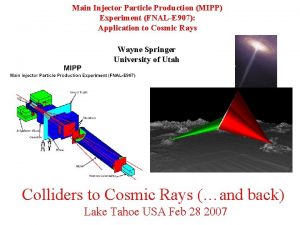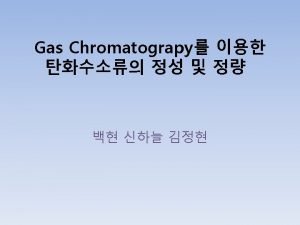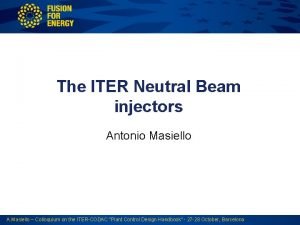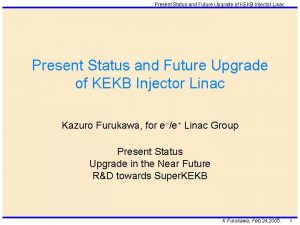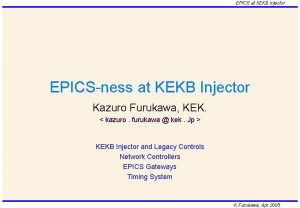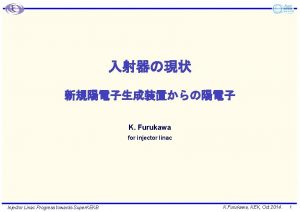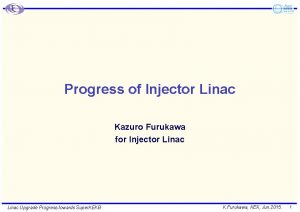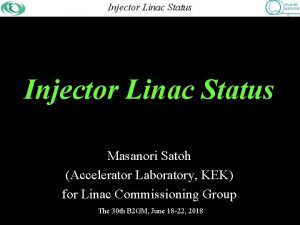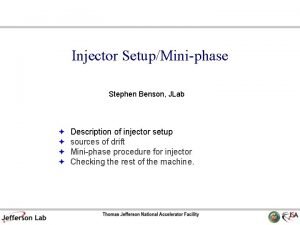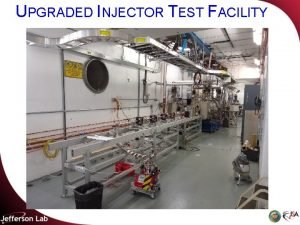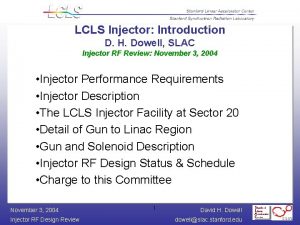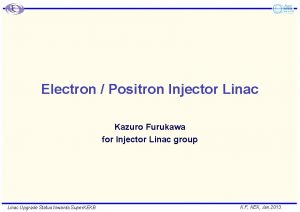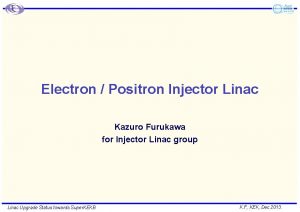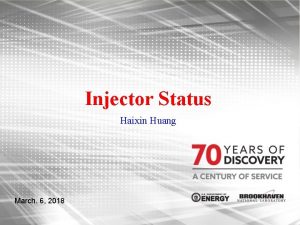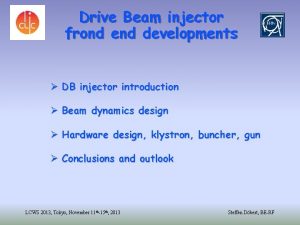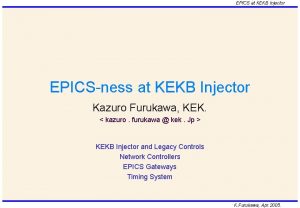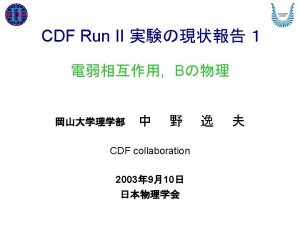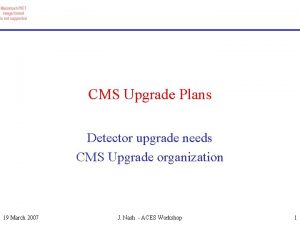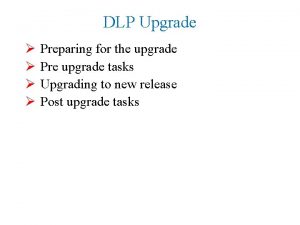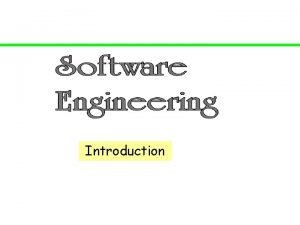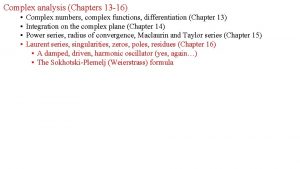Future Upgrade Scenarios for the Injector Complex Upgrade

































![Nominal LHC cycle in the SPS 200 MHz voltage program Beam stability (Rsh [MOhm]) Nominal LHC cycle in the SPS 200 MHz voltage program Beam stability (Rsh [MOhm])](https://slidetodoc.com/presentation_image_h/05f3db3a99de845829ff242644a30158/image-34.jpg)


- Slides: 36

Future Upgrade Scenarios for the Injector Complex Upgrade possibilities in the SPS E. Shaposhnikova for SPSU SG LHC Performance Workshop – Chamonix, 28. 01. 2010

Outline o o Present status SPS limitations Possible actions Summary Acknowledgments: SPS Upgrade Study Group BE/RF: T. Bohl, E. Ciapala, W. Hofle, T. Linnecar, E. Montesinos, J. Tuckmantel 28/01/2010 Chamonix 2010 2

SPS Upgrade Study Group (BE, TE), since March 2007: G. Arduini, J. Bauche, F. Caspers, S. Calatroni, P. Chiggiato, K. Cornelis, E. Mahner, E. Metral, G. Rumolo, B. Salvant, E. Shaposhnikova, M. Taborelli, C. Yin Vallgren, F. Zimmermann + contributions from different groups (ABP, ABT, BI, MSC, OP, RF, VSC…) + impedance team (chaired by E. Metral) Main tasks: • Identify limitations for intensity increase above nominal • Study and propose solutions • Design report with cost and planning for proposed actions Meetings (~1/month), talks, minutes: http: //cern. ch/spsu/ 28/01/2010 Chamonix 2010 3

SPS: present achievements SPS record at 450 Ge. V/c Parameters LHC request 25 ns FT bunch intensity/1011 1. 2 0. 13 1. 2 1. 8 number of bunches in SPS 288 4200 288 total intensity/1013 3. 5 5. 2 nominal ultimate long. emittance [e. Vs] 0. 7 0. 8 <1. 0 norm. H/V emitt. [μm] 3. 6 8/5 3. 5 → SPS upgrade is necessary for intensity above nominal LHC 28/01/2010 Chamonix 2010 4

SPS beams with PS 2 With PS 2 at 50 (25) Ge. V/c Parameters SPS record at 450 Ge. V/c LHC 25 ns LHC 50 ns FT 25 ns LHC 25 ns FT 5 ns 4. 0 5. 5 1. 2 0. 13 number of bunches 2 x 168 2 x 84 815 288 4200 total intensity /1013 13. 4 4. 6 10. 0 3. 5 5. 3 [e. Vs] 0. 6 0. 7 0. 4 0. 6 0. 8 norm. H/V emitt. [μm] 3. 0 9/6 3. 6 8/6 bunch spacing bunch intensity /1011 long. emittance M. Benedikt et al. , PS 2 WG 28/01/2010 Chamonix 2010 5

SPS upgrade for I. Ultimate LHC intensity - 26 Ge. V/c injection – 1. 7 x 1011/bunch, 25 ns spacing, 288 bunches II. PS 2 max. intensity - 50 Ge. V/c injection – 4 x 1011/bunch, 25 ns spacing, 336 bunches, total 1. 3 x 1014 – 5. 5 x 1011/ bunch, 50 ns spacing, 168 bunches 28/01/2010 Chamonix 2010 6

Intensity limitations identified • Single bunch effects: – TMCI (transverse mode coupling instability) – space charge • Multi-bunch effects: – – – beam loss e-cloud longitudinal coupled bunch instabilities beam loading in the 200 MHz and 800 MHz RF systems heating of machine elements (MKE, MKDV kickers, …) vacuum (beam dump and MKDV outgassing), septum sparking (ZS was a main limitation in 2008 and 2009 → 3 nominal LHC batches) 28/01/2010 Chamonix 2010 7

Single bunch effects Space charge • Limit for space charge tune spread (ppbar): 0. 07 • 26 Ge. V/c nominal intensity: 0. 05 ultimate intensity: 0. 07 • 50 Ge. V/c 5. 5 x 1011 (max PS 2): 0. 06 Microwave instability • After impedance reduction (2001) is not observed even for small long. emittances 28/01/2010 TMCI • Threshold intensity scales (matched voltage) ~ εLη • Threshold (impedance model fit to measurements) ~ 1. 4 x 1011 Cures: higher chromaticity, εL, impedance reduction… but 4050% of transverse SPS impedance is still unknown → ongoing work (impedance team) • 50 Ge. V/c – factor 2. 5 increase in the TMCI threshold ~ η → 3. 5 x 1011 Chamonix 2010 8

SPS limitations: beam loss • Significant particle loss for nominal LHC beam (flat bottom + capture): from 20% at the beginning of year to 10% at the end • Relative losses increase with beam intensity, strong dependence on batch intensity, less on total (number of batches) • Much smaller (~5%) relative losses for 75 ns and 50 ns bunch spacing for the same bunch intensity → not single bunch effect; loss decrease during scrubbing run; different lifetime in the head and tail of batch → e-cloud? To have the same absolute losses relative losses should be reduced for higher intensities → the origin of beam loss coast at 26 → e-cloud mitigation Ge. V/c → beam collimation (? ) hea d tail T. Bohl et al. 28/01/2010 Chamonix 2010 LHC batch 9

SPS limitations: e-cloud • Pressure rise, transverse emittance blow-up, beam losses, instabilities • Cures: scrubbing run, high V chromaticity, feedback (H) • Beam energy dependence: o H-plane: e-cloud instability growth time ~ beam energy o V-plane: instability threshold is decreasing with energy (for constant norm. emittances, bunch length and matched voltage) • • • Studies of the scaling law in the SPSU SG: HEADTAIL simulations measurements during ramp with reduced chromaticity and damper gain special cycle with flat portion at 55 Ge. V/c → dependence on transverse size confirmed (G. Rumolo et al. PRL, 100, 2008) 28/01/2010 Chamonix 2010 10

e-cloud mitigation SPS requirements: • applicable to the existing stainless steel vacuum chamber inside 6 m long magnets without dismantling • no aperture reduction (thickness < 0. 5 mm) • no bake-out above 120 deg • no re-activation • no ageing with venting • low impedance • long-term stability • good vacuum properties, no (small) outgassing 28/01/2010 Chamonix 2010 11

Possible e-cloud mitigation • Coatings Ø low SEY amorphous carbon (a-C), SEY < 1 (1. 3 is critical for SPS), stainless steel (St. St) – 2. 5 (1. 5 after scrubbing) o rough surfaces • Clearing electrodes all along the beam pipe o fixing (needs 600 -800 deg) o impedance • Grooves (M. Pivi et al. ) o manufacture, test with beam, aperture, impedance • Active damping system in V plane (W. Hofle et al. , LARP) o feasibility (instability growth rate, frequency) o large bandwidth o incoherent effects 28/01/2010 Chamonix 2010 12

e-cloud experimental set-up in 2008 -2010 • 4 strip-line monitors XSD: (1)-(2) St-St for reference and pressure measurement (new) (3) - old a-C coating (4) – a-CZr (rough) • Clearing (enamel) electrodes with button PUs (2008) • C - magnet with exchangeable samples (St-St in 2008, a-C in 2009) Plus e-cloud set-ups in PS and Linac 3 (a-C, clearing electrodes) 28/01/2010 Chamonix 2010 13

Possible vacuum chamber modification • 2009: • 3 MBB spare magnets coated with a-C (60 mm top& bottom) • installed in the SPS (LSS 5) with microwave and vacuum diagnostics • MDs with LHC beam • 2010: • 1 MBB is out of ring for inspection • design of new coating system • modified microwave and vacuum diagnostics for 2 coated magnets 28/01/2010 Chamonix 2010 coating bench in bld. 867 14

Results for a-C coating Stainless steel Liners: • 300 times smaller e-signal in a-C than in St. St • conditioning (scrubbing) even for small SEY • no ageing for a-C liners exposed to the beam (4 times less signal in old a-C) Magnets: a-Carbon C-8 • absence of e-cloud confirmed by microwave transmission measurements (last MD in 2009), • but no significant reduction in pressure rise Ti. N coating was successfully used in PEP-II, but doesn’t work so far in SNS ring M. Taborelli et al. 28/01/2010 Chamonix 2010 15

a-C coating: open questions • Long term behavior – ageing with venting and scrubbing • What should be coated (dipoles, quadrupoles, pumping port shields + )? 28/01/2010 • Coating quality control • Pressure (outgassing) Chamonix 2010 16

AEC’ 09: anti e-cloud coatings (that do not require activation) workshop CERN 12 -13. 10. 2009 (with ACCNET) 40 participants, 13 external talks CERN talks: 1 SPS upgrade plan & coating requirements – E. Shaposhnikova 2 What should be coated – G. Rumolo 3 Characterization of amorphous carbon coatings – M. Taborelli 4 Results on amorphous carbon coatings in e-cloud monitors of SPS – C. Yin Vallgren 5 Results and plans of CESR-TA experiments on low SEY coatings – S. Calatroni 28/01/2010 6 Diagnostic of coating results – microwave measurements – S. Federmann 7 Diagnostics of coating results – pressure measurements – M. Taborelli 8 Impedance of coating – D. Seebacher 9 Amorphous carbon coating of SPS dipoles – P. Pinto Costa 10 Possible logistics of coating of SPS – J. Bauche 11 Clearing electrodes: the PS experience – E. Mahner Chamonix 2010 17

Possible vacuum chamber modification Implementation in the SPS • 750 vacuum chambers inside dipoles can be treated in 3 -4 shutdowns • Experience due to installation of RF shields (1999 -2001) and refurbishing of the cooling circuits of dipoles (20072009) • Infrastructure partially exists (ECX 5 cavern - ø 20 m) S. Sgobba 28/01/2010 • Vacuum system (for coated chamber) - minimize air exposure during shutdowns and interventions Chamonix 2010 18

SPS limitations: impedance (1/2) Quadrupole oscillation frequency as a function of bunch intensity: slope ~ Im Zeff 28/01/2010 • 1999 -2001: SPS impedance reduction in preparation for nominal LHC beam • 2003 -2006: impedance increase due to re-installation of 8 MKE (extraction kickers for LHC) – main contribution to longitudinal broadband impedance budget (beam measurements and simulations) • 2007 -2010: small reduction (MKE) - not measurable yet Chamonix 2010 19

SPS limitations: impedance (2/2) • Search for unknown impedances: § transverse (broad-band) : only 60% known → TMCI § longitudinal (narrow-band - HOMs) → coupled-bunch instability → SPS impedance budget from all elements (impedance team) • Known high impedance elements: § MKE (M. Barnes): serigraphy (optimised? ) – 3 done, 5 more in 3 years. Transverse impedance issue. New design? § MKDV, MKDH: 30 years old, no transition pieces between magnet and tank → heating, outgassing with 50 ns (MKDV 1) and 75 ns (MKDV 2) spaced beams. Spare MKDV 1 with trans. pieces is now in the ring - OK § 800 MHz TW cavities: active damping → RF feedback and feedforward (2009 -2010), installation of probes in each cell (37/cavity) 28/01/2010 Chamonix 2010 20

SPS limitations: coupled-bunch instability Bunch length (av. , max-min) at 450 Ge. V/c Beam stability from ∆τ G. Papotti et al. Threshold ~1/5 nominal LHC bunch intensity → FB, FF, dampers, 800 MHz RF (in bunch-short. mode) + controlled emittance blow-up: 0. 42 → 0. 65 e. Vs → larger emittance needed for higher intensities – more RF! 28/01/2010 Chamonix 2010 21

200 MHz RF system in the SPS • 4 Travelling Wave cavities: 2 of 5 sections 2 of 4 sections 11 cells/section 18 sections + 2 spares • Total voltage: 8. 0 MV • Power/cavity (E. Montesinos): – 700 k. W for full ring (CNGS) – 1(1. 4) MW for half ring (LHC) possible in pulsed mode (not tested yet) – limited by power amplifier, couplers and feeder lines 28/01/2010 Chamonix 2010 22

200 MHz RF system in the SPS • • Power (1 MW) and voltage (7. 5 MV) limitations are still OK for acceleration of the ultimate LHC beam But if larger emittances (ε~√N) are required for beam stability in the SPS or in LHC beam transfer to the LHC Power/cavity (LHC cycle) for different intensities 400 MHz RF system becomes critical: Since τ~(ε/V 1/2)1/2 • → for τ = const V=V 1 Nult/Nnom = 1. 48 V 1 = 10. 3 MV Two possible solutions are: – to install the 200 MHz RF system in the LHC (E. Ciapala talk) – to rearrange the SPS 200 MHz RF 28/01/2010 Chamonix 2010 Voltage program: flat top - 7. 5 MV acceleration – max 4. 5 MV 23

200 MHz TW RF system: voltage/cavity Pmax=1. 4 MW/cavity Pmax=1. 0 MW/cavity • 5 -section cavities become less efficient at ultimate LHC current for power limit of 1. 4 MW/cavity (T. Bohl, Chamonix 2000) and “useless” for 1 MW/cavity • More voltage can be obtained by rearranging existing 4 cavities into 5 (3 x 4+2 x 3 = 18) or 6 (2 x 4+4 x 3) cavities • Total power increase by 25% or 50% (5 or 6 cavities) 28/01/2010 Chamonix 2010 24

SPS RF system modification: impedance reduction Total beam (peak) impedance of the 200 MHz TW RF system Z= R/8 ∑Ln 2 =RL 2/8 ∑ (n-1/11)2 R=27. 1 k. Ohm/m 2, n - number of sections per cavity Ln=L (n-1/11), L=11 x 0. 374 m, RL 2/8=57. 3 k. Ohm 4 cav. 2 x 5 & 2 x 4: Z = 4. 5 MOhm - now 5 cav. 2 x 3 & 3 x 4: Z = 3. 6 MOhm - 20% less 6 cav. 4 x 3 & 2 x 4: Z = 3. 7 MOhm - 18% less → We have two more cavities in the SPS and reduce impedance! (To compare with installation of the 200 MHz in LHC) 28/01/2010 Chamonix 2010 25

Total 200 MHz voltage on SPS flat top nominal ultimate § Existing configuration will have problems at ultimate LHC current even at 1 MW §The same voltage for ultimate current as for nominal could be obtained with 6 cavities and power of 1 MW 28/01/2010 Chamonix 2010 26

FT/CNGS acceleration cycle Limitation for voltage required for acceleration for Pmax=0. 7 MW 4200 bunches spaced by 5 ns 0. 73 A - RF current for N = 4. 8 1013 (nominal CNGS) § Presently both voltage and power are at the limit: 7. 5 MV used after transition crossing (uncontrolled emittance blow-up) § Significant improvement for CNGS and fast LHC cycle with 6 cavities 28/01/2010 Chamonix 2010 27

200 MHz TW RF system upgrade summary § How many: significant gain in voltage even with 5 cavities, restored performance for LHC ultimate beam and improved for CNGS with 6 cavities § Where: 1 or 2 cavities in LSS 5 in addition to 4 shorter cavities in LSS 3 (now) – civil engineering, cavity and beam control § When: start project now to be ready for 2015 (Linac 4) § For maximum PS 2 intensities (5. 2 A) – more short cavities and power, 2 power plants (2 feeder lines) per cavity, … 28/01/2010 Chamonix 2010 28

FT/CNGS beam in SPS with PS 2 with PS ←one PS cycle→ • SPS filling factor 0. 91 • two gaps of 1. 05 μs each • transition crossing • no bunch-to bucket transfer with PS 2 ←one PS 2 cycle (5 -turn extract. ) → • no transition crossing • bunch-to-bucket transfer • no flat bottom • SPS/PS 2 geometrical gap: 0. 6 μs, min PS 2 kicker gap: 0. 3 μs → max SPS gap of 0. 9 μs (1. 05 μs now) for the same SPS filling factor as now (0. 91) • CNGS beam: MKE rise time and kick length (max 12 μs now) → for fast extraction of full ring 5 x 1. 05+0. 6 = 5. 85 μs total gap! → 0. 9 μs kicker rise time and 22 μs kick length (B. Goddard) 28/01/2010 Chamonix 2010 29

Internal beam dump (LSS 1) Limitations • TIDGV: energy range 105 -450 Ge. V, TIDH for beams < 37 Ge. V → no dumping possible in range (37 -105) Ge. V • TIDVG (M. Genbrugge, Y. Kadi, A. Stadler): • outgassing during dumps, pressure rise → interlock (MKP) • limits for dumping current and future beams (Antico T< 450 o) • absorbs only 155 Ge. V/p (at 450 Ge. V) → New design for higher intensities • MKDV (M. Barnes, B. Goddard): • injection at 50 Ge. V → larger dynamic range of the switch • kicker rise time >1 μs → beam gaps with PS 2 (FT beam) • impedance (heating, outgassing)) → Development of fast semiconductor switch 28/01/2010 Chamonix 2010 30

Hardware modifications • • • For ultimate LHC intensity ZS (electrostatic septa) – show-stopper for nominal LHC beam in 2008 -2009 Impedance reduction – MKE, MKDV, MKDH + more (as identified) SPS magnet coating after successful tests (in 2013/2014 ? ) Vacuum system (for coated chamber) 200 MHz RF system, beam control, transverse damper low-level control Plus for PS 2 • More RF power, cavities, beam control • Transverse damper • Beam dump (TIDVG) • Dump kickers (MKDV/H), injection kickers (MKP) • Beam collimation • Radioprotection • Beam instrumentation Chamonix 2010 28/01/2010 • … 31

Summary • • • Main SPS limitations for ultimate intensity have been identified, measures to overcome them are under study (limited by resources) Machine development (MD) sessions with higher than nominal intensity needed to see other possible limitations (obtained by scaling so far) Recent work in the SPSU SG is mainly concentrated on e-cloud mitigation, a -C coating of vacuum chamber is the best candidate for implementation The SPS RF system upgrade is required for ultimate intensities, also reduces pressure for installation of the capture system in LHC e-cloud mitigation, impedance reduction and RF upgrade would help for nominal and ultimate LHC beam operation and can be implemented earlier In the upgrade plan with PS 2, the SPS will have a higher injection energy which helps to overcome some high intensity limitations (single bunch, injection losses) and avoid transition crossing for CNGS/FT beam. Needs many studies and hardware modifications. 28/01/2010 Chamonix 2010 32

Spare slides 28/01/2010 Chamonix 2010 33
![Nominal LHC cycle in the SPS 200 MHz voltage program Beam stability Rsh MOhm Nominal LHC cycle in the SPS 200 MHz voltage program Beam stability (Rsh [MOhm])](https://slidetodoc.com/presentation_image_h/05f3db3a99de845829ff242644a30158/image-34.jpg)
Nominal LHC cycle in the SPS 200 MHz voltage program Beam stability (Rsh [MOhm]) through the cycle in single and double RF + 800 MHz 200 MHz • Voltage for acceleration of the nominal LHC beam is well below limit except on flat top • Flat top – transfer to 400 MHz LHC RF 28/01/2010 Chamonix 2010 34

200 MHz RF system for higher intensities – where? in LHC • • in SPS 8 bare cavities exist plus tuners and HOM damping loops from the SW 200 MHz ; we have a low power coupler two identical systems (4 cavities/ beam) → cost, maintenance reduce reliability no access during operation partial solution: beam still needs to be transferred to the 400 MHz RF system increase LHC impedance significantly (factor 4) reduce beam stability unless used with the 400 MHz RF system as a Landau cavity 28/01/2010 • rearrange existing 4 cavities into 5 or 6 cavities of shorter length with 1 or 2 extra power plants to – reduce beam loading per cavity – increase available voltage (~number of cavities) – reduce beam coupling impedance – accessible on the surface • necessary first step for further intensity increase in the SPS (with PS 2 as injector) Chamonix 2010 35

SPSU budget in 2008 -2012 Year 2008 2009 2010 2011 2012 Total allocated (k. CHF) 333 187 200 180 1100 339 188 10 spent (k. CHF) Plus 10 man-years were foreseen 2008: - SPS set-up for e-cloud tests - samples, SEY measurements +UHV - coating system design - C-magnets, cables - clearing electrodes, grooves - Ph. D student (1/2 year) 28/01/2010 2009: - SPS set-up for e-cloud tests - samples , SEY measurements - coating system - 3 SPS magnet coating & installation - microwave diagnostics, cables 2010: - coating system development: 234 k. CHF - residual gas analyser, calorimeter: 31 k. CHF -. . . Chamonix 2010 36
 Future continuous and future perfect simple
Future continuous and future perfect simple Future perfect e future continuous
Future perfect e future continuous Oecd scenarios for the future of schooling
Oecd scenarios for the future of schooling Mazzei injector selector
Mazzei injector selector Mars injector
Mars injector Keburukan injector cleaner
Keburukan injector cleaner Cana injector
Cana injector What causes a bell mouthed kerf
What causes a bell mouthed kerf Iter coils
Iter coils Kioritz soil injector
Kioritz soil injector Cana injector
Cana injector How stuff works
How stuff works Weber number
Weber number Electron injector
Electron injector Mixrite radio
Mixrite radio Career point
Career point Biolab oxygen injector
Biolab oxygen injector Oxy blast for sale
Oxy blast for sale Wankel
Wankel Acceleratorclientconnectioncallback
Acceleratorclientconnectioncallback Bill nye fuel injector
Bill nye fuel injector Michigan ffa skills contest
Michigan ffa skills contest Hypo hatchet tree injector
Hypo hatchet tree injector Injector update
Injector update Fnale
Fnale Pressure regulator
Pressure regulator Uuu injector
Uuu injector Splitless injector
Splitless injector Antonio masiello
Antonio masiello Simple compound complex and compound-complex sentences quiz
Simple compound complex and compound-complex sentences quiz Oedipus complex and electra complex
Oedipus complex and electra complex Psychodynamic theory of personality
Psychodynamic theory of personality Miliary tb
Miliary tb Mbti breakdown
Mbti breakdown Simple, compound and complex sentences quiz
Simple, compound and complex sentences quiz Examples of past continuous interrupted
Examples of past continuous interrupted Future continuous
Future continuous





